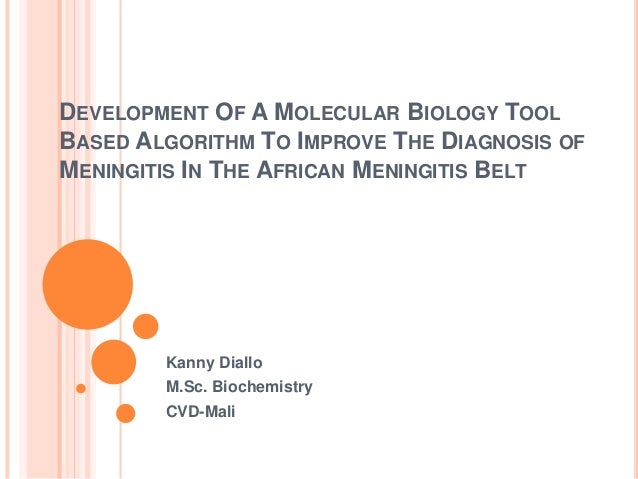
Kanny Diallo presents on the development of a molecular biology tool based algoritm to improve the diagnosis in the african meningitis belt
- 1. DEVELOPMENT OF A MOLECULAR BIOLOGY TOOL BASED ALGORITHM TO IMPROVE THE DIAGNOSIS OF MENINGITIS IN THE AFRICAN MENINGITIS BELT Kanny Diallo M.Sc. Biochemistry CVD-Mali
- 2. MENINGITIS IN THE AFRICAN BELT • Meningitis is an inflammation of the meninges that affects the brain membranes: - causes: bacteria, viruses or other micro-organisms - consequences: life threatening damages, complicated sequelaes •In the African belt: -Recurrent epidemic -2009 epidemic season: 14 African countries enhanced surveillance 88,199 suspected cases, 5,352 deaths, Largest number since 1996 epidemic • Importance of rapid and cost efficient Diagnosis and Intervention tool Source: Control of epidemic meningococcal disease, WHO practical guidelines, World Health Organization, 1998, 2nd edition, WHO/EMC/BAC/98.3
- 3. MENINGITIS IN THE AFRICAN BELT Major cause of meningitis in the African Belt is Neisseria meningitidis serogroup A (N.m.A) ..DocumentsCVD-MaliMRF projectmeetingsMRF visitBulletinMeningite2012_S31_35.pdf 1996 188,345 1978 80,743 1989 88,939 2001 68,089 (WHO Epidemiological Review 2007)
- 4. MENAFRIVAC Neisseria meningitidis is a bacteria that is commensal to the internal flora of the throat - healthy carriage is the most common stage - there are 12 capsulated serogroups (A, B, C, W, Y,E,H, Z, I K, L X) Polysaccharide vaccines have been previously developed - short lasting immunity - not immunogenic in kids and infant In December 2010, a new conjugate vaccine was introduced in the meningitis belt, against N.m.A: - supposed to elicit long term immunity - can be used on children - very low cost - claim to be able to eliminate carriage of N.m.A
- 5. MENAFRICAR MenAfriCar is a global research effort to determinate the level of meningococcal carriage in 7 countries of the Meningitis African Belt and to evaluate the impact of the MenAfriVac vaccine on carriage and immunity. Traditional microbiology and biochemistry methods have been used to identify the different strains of N.m in a cohort of participants in all selected countries Immunologic status of ~ 1000 participants will be evaluated before vaccination by MenAfriVac in selected countries using ELISA and SBA techniques Molecular biology was introduced in all participating centres via a simple traditional PCR to confirm the serogroups of N.m suspected strains
- 6. VISIT IN A PARTICIPANT FAMILY
- 7. TRADITIONAL MICROBIOLOGY • Neisseria meningitidis: Oxidase positive, Gram negative, diploccocus, • GGT positive, ONPG negative, tributyrin negative • Sero-agglutination • minimum 3 days of testing • Not always efficient (cross-reaction, subjectivity of visual results…) • BETTER DIAGNOSIS TOOLS ARE NEEDED
- 8. MENINGITIS RESEARCH FOUNDATION GRANT “Development of an African adapted PCR algorithm to characterize non-groupable isolates of Neisseria meningitidis” Written by Dr Olivier Manigart in 2009 with help of Prof Samba Sow, Prof Martin Maiden and Prof Ray Borrow Accepted in 2010 but started only in 2012 due to difficulty to find good candidate to work both on this project and MenAfriCar
- 9. MOLECULAR BIOLOGY • most of the N.m genome sequences are available • Using the species and serogroups specific genes allows direct targeting of the bacteria • PCR allows amplification of the bacterial DNA using specific primers and luminescent probes • Can be done in 1 to 2 days depending on DNA extraction techniques • Requires good GCLP practices to avoid contaminations
- 10. REAL TIME PCR • Similar to gel base PCR, but risks of contaminations are reduces (closed system) • Semi-automated, we use the ABI 7500 fast machine, that allow us to visualise amplification on a computer screen • Fast and accurate: our program run for 2 hours • Primers and probes designs and optimisation of the technique
- 11. REAL TIME PCR OPTIMISATION oIn this paper they used real time PCR to differentiate between N.meningitidis, S. pneumoniae and H. influenzae o They have designed primers specific for N.m but also for serogroups A, W, X, Y, B, C
- 12. AKNOWLEDGEMENT o MRF oMenAfriCar: Dr Olivier Manigart and all the team oCVD-Mali: Prof Samba Sow, Dr Tamboura, and all the team oLondon School of Hygiene and Tropical Medicine (Pr Brian Greenwood) oCDC- Atlanta: Dr Xin Wang oOxford University Zoology department: Pr Maiden, Dr Odile Harisson oVEU, Health Protection Agency, Manchester: Pr Borrow
Notas do Editor
- caused by different bacteria that are spread throug contact with infected aerosols Can lead to severe damage, and leave important sequelaes if not rapidly detected and treated African belt: arid region of subsaharian africa stretching from senegal to ethiopia The fatality rate is important during epidemics
- Nigeria removed due to political problems in the region Discuss the fact that no N.mA was found in Mali and Niger the pre-post analysis will only happen in Chad Discuss the results differences ELISA: Enzyme linked immunosorbent assay SBA: serum bactericidal assay
- I don’t agree that primers design is more difficult for real-time. Probes are additional (thus more work)
